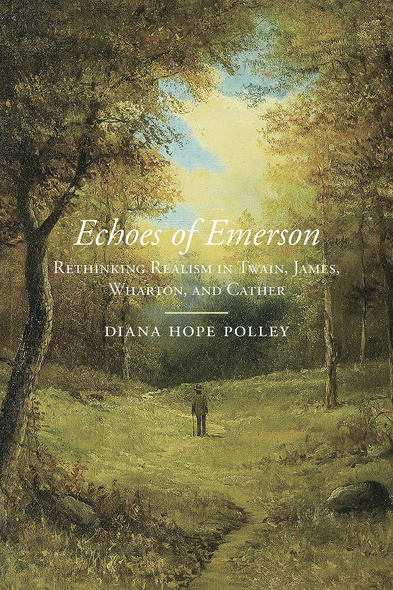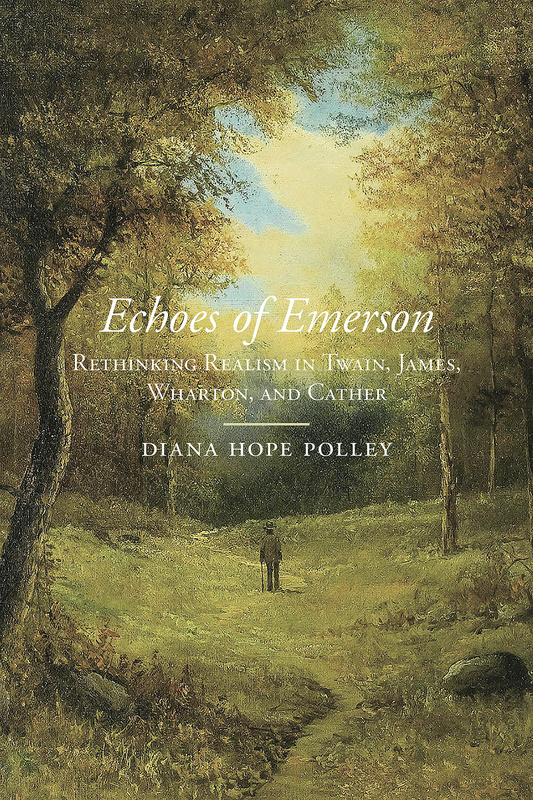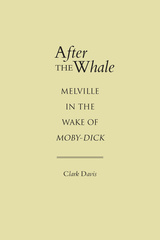Echoes of Emerson
Rethinking Realism in Twain, James, Wharton, and Cather
University of Alabama Press
Winner of the 2018 Robert Penn Warren—Cleanth Brooks Award for Outstanding Literary Scholarship and Criticism” from the Center for Robert Penn Warren Studies at Western Kentucky University
Probes the ways in which two major periods in nineteenth-century American literature—Romanticism and Realism—have come to be understood and defined.
Echoes of Emerson: Rethinking Realism in Twain, James, Wharton, and Cather traces the complex and unexplored relationship between American realism and the philosophy of Ralph Waldo Emerson. Critics often read American realism as a clear disavowal of earlier American romantic philosophy and as a commitment to recognizing the stark realities of a new postbellum order. Diana Hope Polley’s study complicates these traditional assumptions by reading American realism as an ongoing dialogue with the ideas—often idealisms—of America’s greatest romantic philosopher, Ralph Waldo Emerson.
In this illuminating work, Polley offers detailed readings of Mark Twain’s Adventures of Huckleberry Finn, Henry James’s The Portrait of a Lady, Edith Wharton’s The House of Mirth, and Willa Cather’s My Ántonia—all through the lens of Emersonian philosophy and discourse. This unique contribution to nineteenth- and early twentieth-century literary studies shows how these texts revisit Emerson’s antebellum “republic of the spirit” philosophy, specifically the trope of the Emersonian hero/heroine navigating the harsh contingencies of the modern world.
Romanticism and realism are often seen as opposing binaries, with romanticism celebrating the individual, self-reliance, and nature and realism emphasizing the weight of socio-historical forces. Realism is often characterized as rejecting the transcendent principles of Emersonian thought. Rather than accept those distinct boundaries between romance and realism, Polley argues that American realists struggled between celebrating Emerson’s core philosophies of individual possibility and acknowledging the stark “realities” of American social and historical life. In short, this study recognizes within realism a divided loyalty between two historical trends and explores how these seemingly contradictory notions—Emerson’s romantic philosophy and later nineteenth-century visions of historical reality—exist, simultaneously, within the literature of the period.
Probes the ways in which two major periods in nineteenth-century American literature—Romanticism and Realism—have come to be understood and defined.
Echoes of Emerson: Rethinking Realism in Twain, James, Wharton, and Cather traces the complex and unexplored relationship between American realism and the philosophy of Ralph Waldo Emerson. Critics often read American realism as a clear disavowal of earlier American romantic philosophy and as a commitment to recognizing the stark realities of a new postbellum order. Diana Hope Polley’s study complicates these traditional assumptions by reading American realism as an ongoing dialogue with the ideas—often idealisms—of America’s greatest romantic philosopher, Ralph Waldo Emerson.
In this illuminating work, Polley offers detailed readings of Mark Twain’s Adventures of Huckleberry Finn, Henry James’s The Portrait of a Lady, Edith Wharton’s The House of Mirth, and Willa Cather’s My Ántonia—all through the lens of Emersonian philosophy and discourse. This unique contribution to nineteenth- and early twentieth-century literary studies shows how these texts revisit Emerson’s antebellum “republic of the spirit” philosophy, specifically the trope of the Emersonian hero/heroine navigating the harsh contingencies of the modern world.
Romanticism and realism are often seen as opposing binaries, with romanticism celebrating the individual, self-reliance, and nature and realism emphasizing the weight of socio-historical forces. Realism is often characterized as rejecting the transcendent principles of Emersonian thought. Rather than accept those distinct boundaries between romance and realism, Polley argues that American realists struggled between celebrating Emerson’s core philosophies of individual possibility and acknowledging the stark “realities” of American social and historical life. In short, this study recognizes within realism a divided loyalty between two historical trends and explores how these seemingly contradictory notions—Emerson’s romantic philosophy and later nineteenth-century visions of historical reality—exist, simultaneously, within the literature of the period.
In American literature, the Civil War provides a historical bookend: critics place romanticism on the antebellum book shelf and realism on the postbellum one, separating the two periods in a supposedly neat fashion. This periodization influences not only how American literature is taught, but also how these genres and their relationship to one another are imagined. . . . Polley advocates a revision of periodization, a claim for all literary critics to consider, not just those who study American realism.’
—Studies in the Novel
‘Echoes of Emerson is elegantly written and sharply conceived. While this intertextual study will appeal to advanced students of literature and philosophy, it will also attract readers who appreciate the complex dialogue between ideas and authors that Polley constructs.’
—Ann M. Ryan, former editor of The Mark Twain Annual and coeditor of Cosmopolitan Twain
Marking the Civil War as a watershed moment that changed American literature, Polley, in Echoes of Emerson, traces the rise of realism. She dismisses early claims that realism was no more than a continuation of a Romantic mythology found in the works of Washington Irving, Nathaniel Hawthorne, and Ralph Waldo Emerson, and she also dismisses more recent claims that realism was simply a reaction to and a rejection of the ideal, the Romantic, and the transcendental. Finding a middle ground, Polley employs the theories of M. M. Bakhtin and Raymond Williams to explore the dialectic push and pull between, as she writes in the introduction, ‘residual, dominant, and emergent cultures’ that influenced postbellum writers. After developing her dialectic theory in the introduction, Polley presents four chapters, each assiduously analyzing a realistic novel: Mark Twain’s Adventures of Huckleberry Finn, Henry James’s The Portrait of a Lady, Edith Wharton’s House of Mirth, and Willa Cather’s My Ántonia. In considering these works, Polley draws on Emerson’s writings to show that realists both embraced and rejected Romanticism. In a brief epilogue, she adroitly juxtaposes literary periods and literary histories, accepting that periods exist but also recognizing the residual and emerging historical forces that shaped realism. Highly recommended.'
—Choice
Diana Hope Polley is professor of English at Southern New Hampshire University, University College.
Acknowledgments
Introduction
Chapter 1. Mark Twain’s Adventures of Huckleberry Finn
Chapter 2. Henry James’s The Portrait of a Lady
Chapter 3. Edith Wharton’s The House of Mirth
Chapter 4. Willa Cather’s My Ántonia
Epilogue
Notes
Works Cited
Index






